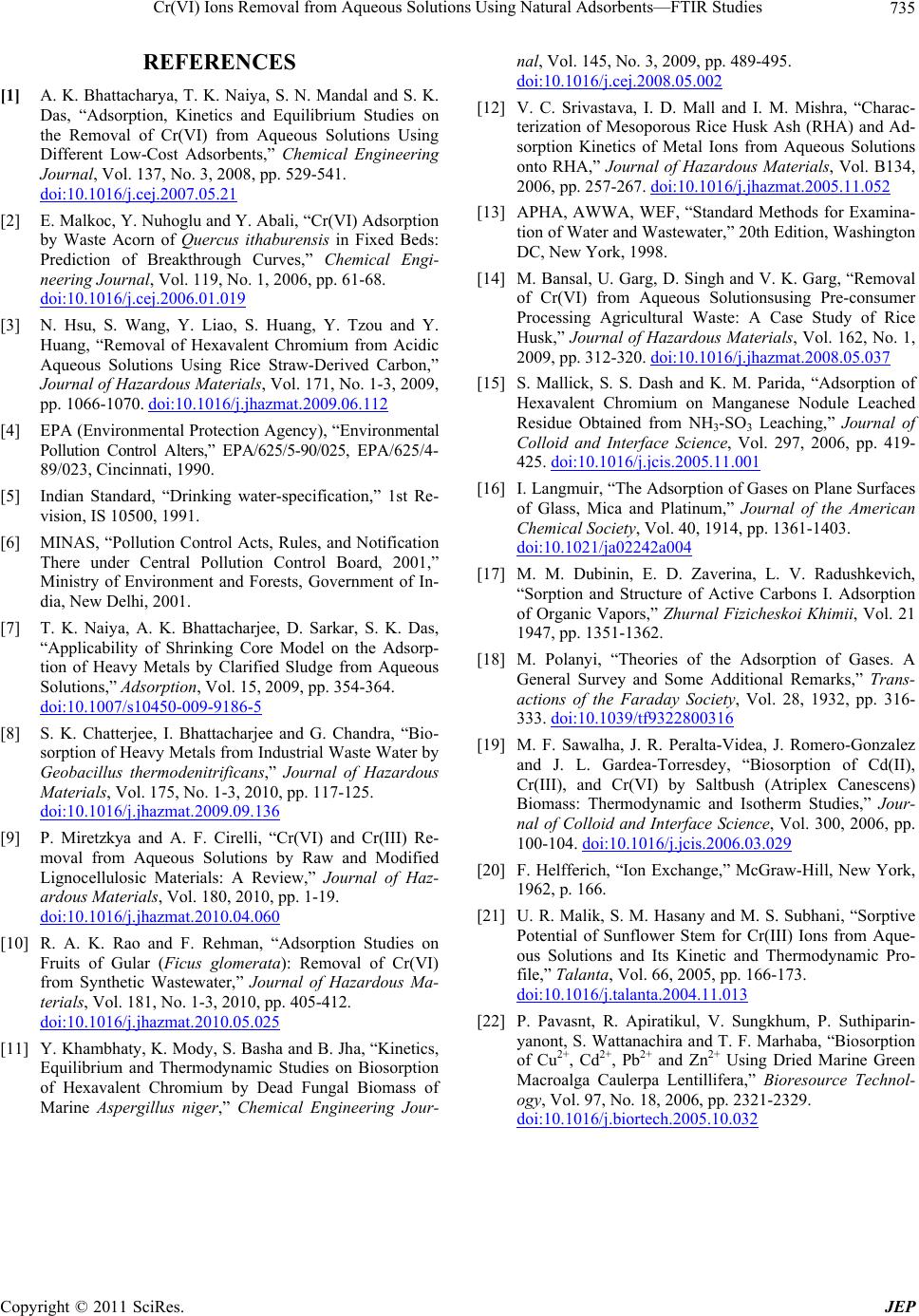
Cr(VI) Ions Removal from Aqueous Solutions Using Natural Adsorbents—FTIR Studies735
REFERENCES
[1] A. K. Bhattacharya, T. K. Naiya, S. N. Mandal and S. K.
Das, “Adsorption, Kinetics and Equilibrium Studies on
the Removal of Cr(VI) from Aqueous Solutions Using
Different Low-Cost Adsorbents,” Chemical Engineering
Journal, Vol. 137, No. 3, 2008, pp. 529-541.
doi:10.1016/j.cej.2007.05.21
[2] E. Malkoc, Y. Nuhoglu and Y. Abali, “Cr(VI) Adsorption
by Waste Acorn of Quercus ithaburensis in Fixed Beds:
Prediction of Breakthrough Curves,” Chemical Engi-
neering Journal, Vol. 119, No. 1, 2006, pp. 61-68.
doi:10.1016/j.cej.2006.01.019
[3] N. Hsu, S. Wang, Y. Liao, S. Huang, Y. Tzou and Y.
Huang, “Removal of Hexavalent Chromium from Acidic
Aqueous Solutions Using Rice Straw-Derived Carbon,”
Journal of Hazardous Materials, Vol. 171, No. 1-3, 2009,
pp. 1066-1070. doi:10.1016/j.jhazmat.2009.06.112
[4] EPA (Environmental Protection Agency), “Environmental
Pollution Control Alters,” EPA/625/5-90/025, EPA/625/4-
89/023, Cincinnati, 1990.
[5] Indian Standard, “Drinking water-specification,” 1st Re-
vision, IS 10500, 1991.
[6] MINAS, “Pollution Control Acts, Rules, and Notification
There under Central Pollution Control Board, 2001,”
Ministry of Environment and Forests, Government of In-
dia, New Delhi, 2001.
[7] T. K. Naiya, A. K. Bhattacharjee, D. Sarkar, S. K. Das,
“Applicability of Shrinking Core Model on the Adsorp-
tion of Heavy Metals by Clarified Sludge from Aqueous
Solutions,” Adsorption, Vol. 15, 2009, pp. 354-364.
doi:10.1007/s10450-009-9186-5
[8] S. K. Chatterjee, I. Bhattacharjee and G. Chandra, “Bio-
sorption of Heavy Metals from Industrial Waste Water by
Geobacillus thermodenitrificans,” Journal of Hazardous
Materials, Vol. 175, No. 1-3, 2010, pp. 117-125.
doi:10.1016/j.jhazmat.2009.09.136
[9] P. Miretzkya and A. F. Cirelli, “Cr(VI) and Cr(III) Re-
moval from Aqueous Solutions by Raw and Modified
Lignocellulosic Materials: A Review,” Journal of Haz-
ardous Materials, Vol. 180, 2010, pp. 1-19.
doi:10.1016/j.jhazmat.2010.04.060
[10] R. A. K. Rao and F. Rehman, “Adsorption Studies on
Fruits of Gular (Ficus glomerata): Removal of Cr(VI)
from Synthetic Wastewater,” Journal of Hazardous Ma-
terials, Vol. 181, No. 1-3, 2010, pp. 405-412.
doi:10.1016/j.jhazmat.2010.05.025
[11] Y. Khambhaty, K. Mody, S. Basha and B. Jha, “Kinetics,
Equilibrium and Thermodynamic Studies on Biosorption
of Hexavalent Chromium by Dead Fungal Biomass of
Marine Aspergillus niger,” Chemical Engineering Jour-
nal, Vol. 145, No. 3, 2009, pp. 489-495.
doi:10.1016/j.cej.2008.05.002
[12] V. C. Srivastava, I. D. Mall and I. M. Mishra, “Charac-
terization of Mesoporous Rice Husk Ash (RHA) and Ad-
sorption Kinetics of Metal Ions from Aqueous Solutions
onto RHA,” Journal of Hazardous Materials, Vol. B134,
2006, pp. 257-267. doi:10.1016/j.jhazmat.2005.11.052
[13] APHA, AWWA, WEF, “Standard Methods for Examina-
tion of Water and Wastewater,” 20th Edition, Washington
DC, New York, 1998.
[14] M. Bansal, U. Garg, D. Singh and V. K. Garg, “Removal
of Cr(VI) from Aqueous Solutionsusing Pre-consumer
Processing Agricultural Waste: A Case Study of Rice
Husk,” Journal of Hazardous Materials, Vol. 162, No. 1,
2009, pp. 312-320. doi:10.1016/j.jhazmat.2008.05.037
[15] S. Mallick, S. S. Dash and K. M. Parida, “Adsorption of
Hexavalent Chromium on Manganese Nodule Leached
Residue Obtained from NH3-SO3 Leaching,” Journal of
Colloid and Interface Science, Vol. 297, 2006, pp. 419-
425. doi:10.1016/j.jcis.2005.11.001
[16] I. Langmuir, “The Adsorption of Gases on Plane Surfaces
of Glass, Mica and Platinum,” Journal of the American
Chemical Society, Vol. 40, 1914, pp. 1361-1403.
doi:10.1021/ja02242a004
[17] M. M. Dubinin, E. D. Zaverina, L. V. Radushkevich,
“Sorption and Structure of Active Carbons I. Adsorption
of Organic Vapors,” Zhurnal Fizicheskoi Khimii, Vol. 21
1947, pp. 1351-1362.
[18] M. Polanyi, “Theories of the Adsorption of Gases. A
General Survey and Some Additional Remarks,” Trans-
actions of the Faraday Society, Vol. 28, 1932, pp. 316-
333. doi:10.1039/tf9322800316
[19] M. F. Sawalha, J. R. Peralta-Videa, J. Romero-Gonzalez
and J. L. Gardea-Torresdey, “Biosorption of Cd(II),
Cr(III), and Cr(VI) by Saltbush (Atriplex Canescens)
Biomass: Thermodynamic and Isotherm Studies,” Jour-
nal of Colloid and Interface Science, Vol. 300, 2006, pp.
100-104. doi:10.1016/j.jcis.2006.03.029
[20] F. Helfferich, “Ion Exchange,” McGraw-Hill, New York,
1962, p. 166.
[21] U. R. Malik, S. M. Hasany and M. S. Subhani, “Sorptive
Potential of Sunflower Stem for Cr(III) Ions from Aque-
ous Solutions and Its Kinetic and Thermodynamic Pro-
file,” Talanta, Vol. 66, 2005, pp. 166-173.
doi:10.1016/j.talanta.2004.11.013
[22] P. Pavasnt, R. Apiratikul, V. Sungkhum, P. Suthiparin-
yanont, S. Wattanachira and T. F. Marhaba, “Biosorption
of Cu2+, Cd2+, Pb2+ and Zn2+ Using Dried Marine Green
Macroalga Caulerpa Lentillifera,” Bioresource Technol-
ogy, Vol. 97, No. 18, 2006, pp. 2321-2329.
doi:10.1016/j.biortech.2005.10.032
Copyright © 2011 SciRes. JEP